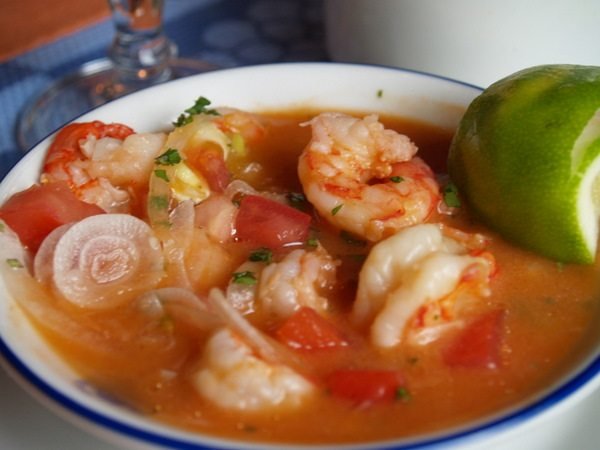Five Dishes I Brought Home from my Travels
Without a doubt one of the best parts of traveling is exploring a destination’s cuisine. (Er, unless it results in amoebic dysentery, but that’s a whole different topic.) I’ve found something to love just about everywhere, but here are five recipes that I often cook at home (to varying degrees of success and authenticity).
Tom Yam Goong? Tom Yum Kung?

However you spell it, this spicy sour shrimp soup from Thailand is a real winner. Back in Bangkok it leaves me in near fits of pain from the spice, but like a drug addiction (I imagine) you keep shoveling it in despite the obvious side effects.
But what to do about that here in the US? When I’m “home” I am in Madison, Wisconsin, and most (all?) of our Thai restaurants are run by Laotians aiming to please local palates. Nothing against them, but their cuisine is a tad different and the influence on Thai dishes is noticeable for someone who is picky as hell about his tom yum. But hey, I’ve even wrinkled my nose at some recipes back in Bangkok. It’s personal taste of course, but it matters.
The biggest problem is finding the right ingredients.
Kaffir lime leaves are, in my opinion, indispensable. I have gotten them often at a couple local Asian markets, but in 2010 they were quarantined by US customs due to a pest problem. That quarantine was allegedly lifted but the Kaffir lime leaves were slow to return (they just did – summer 2011). I can mail order them for a fortune. (Don’t ask me how that could happen when the ban was still in place.)
Lemongrass, no problem, straw mushrooms are often canned here (blech) so I opt for fresh locally-inoculated oyster mushrooms. Shallots, Thai chilies, galangal — all good. Cilantro, the parsley-like version or the saw-blade variety, is also obtainable. But be sure to buy them with the roots still on! Frozen shrimp, uncooked, unpeeled, and for goshsakes, unsalted. (Why does a company salt frozen shrimp??? Preservative?)
Many recipes start with chicken soup stock, say 4 cups, but honestly, that’s not the way it is typically done back in Thailand (though sometimes). In fact, the shrimp still have the heads on so the flavors and fats get into the mix. Throw them into the water to start the broth, take ’em out while you then cook up the batch, and then return them later.
As Mrs. Ya would say during my Thai cooking school experience, Bang! Bang! Chop! Chop! the ingredients to let the flavors out. Pound them a bit with a fish whacker if you want. Add the galangal sliced thinly, the shallots cut up a bit, cilantro/coriander roots, lemongrass cut into 1-inch pieces, and fish sauce to make it salty to taste. Then the Thai chilies, cut and crushed up (be careful, know your limits!), then the mushrooms left in bigger pieces. Some folks add tomato chunks (um… no). Add lime juice to sour it up. Get some Kaffir lime leaves, take the stems out, break them up a bit. Add nam phrik phao, a red chili/oil paste at the end, as well as a few spoonfuls of evaporated milk if you like the cloudy version and not the “clear soup” (I do). Fresh cilantro/coriander leaves on top when you serve it. (Some use sawtooth coriander which is fine also.)
That is the vaguest recipe I’ve ever jotted down, reminiscent of a grandmother’s cooking instructions, but that’s about how it goes. My wife Peung and I usually end up leaning over the soup kettle with a spoon, “Whatya think? More lime? Maybe a bit of sugar? Is it spicy enough? More Kaffir lime! More Kaffir lime! (that’s me)”
Tom yum is typically made fresh in Thailand when you order it. But I find that when I leave a big batch overnight it just gets a little better, in the same way a batch of chili does. But then it starts to decline soon after so don’t push it.
Çılbır (Turkish Poached Eggs)
I have an ex-GF to thank for this one. Even during my year living in Turkey, I never had it at a friend’s house or restaurant, never noticed it on a menu. She taught me when we were back in the States and I’ve loved this dish ever since. Turks love their yogurt, and it is not like Dannon or Yoplait, they don’t mix in sugar and fruit, soy, or Nutrasweet, Splenda or, god help you, Activia. And it’s not just for women (funny yogurt video). There are a good number of dishes — mantı, İskender kebap, haydari — that incorporate yogurt, but cilbir (say “chulbur”) also includes poached eggs and makes for a good breakfast option.
Poaching eggs is easy enough. Boil water and add a bit of vinegar (2 tbs) to it. Once it is boiling, ease back the heat so the water isn’t so violent that it tosses the egg whites all over the place. Crack the eggs first into a small cup or the like and gently ease them into the water. Let them cook for 3 minutes or so, depending on how much liquid you like in your yolk. Remove eggs with a slotted spoon, place them in a bowl to be served, smother with plain yogurt mixed with a bit of fresh minced garlic, sprinkle dried mint flakes on all that and drizzle with “red butter.” What? Red butter??? Start this before you poach the eggs. A couple tablespoons of butter in a sauce pan, melt it on low heat, stir in paprika, and… well, whatya know? Red butter.

Bonus: Ayran – Another way to have yogurt. Peung became such a fan on our recent Turkey trip that she insists I mix some up for her to take to work or have with dinner. She likes the way it fills up a hungry belly. It’s simple: fresh plain yogurt, add water enough to make it drinkable, more or less the consistency of buttermilk, and salt to taste. In Turkey some traditional places serve it in little copper cups with a lot of froth on top.
Melanzane sott’olio – Eggplant in oil

I made a good friend named David Murolo back when I lived in Reggio Calabria in deep south Italy. Toward the end of my year there, he invited me over one night for dinner and I had the most amazing eggplant ever. I ate nearly a whole jar at his mother’s prodding. It’s basically a pickled form of eggplant without being canned, so it doesn’t last forever (not that it could last more than a couple days in my house).
Cut eggplants into thick slices, mix together with salt, fresh pepperoncini (Calabrese spicy if you can), garlic and put in a container where you are able to rest something heavy on top of the whole mix. In a big colander you might rest a plate and place a big rock on top or a container of water. Leave it for 3 days and out comes the bitter water of the eggplant. Squeeze out what you can then and add a bit of vinegar. Leave for five minutes. Press it all once again, pack them into a jar, and mix in olive oil – enough to eliminate air pockets and just to cover the topmost piece of eggplant so that mold can’t form.
In Calabria I’ve also had this with the eggplant cut into little strips, but what I had that night – the best ever – or The Eggplant of God as we called it, was larger slices. Thanks to my friend Luciana I know more or less how to make it (but it’s never the same, eh?)
Pad Krapow Moo Sap Kai Dao

Translates just like the recipe: Fried Basil, Ground Pork, Fried Egg. It can be spicy depending on the hand tossing the peppers into the wok and how finely they are chopped up. The hottest I ever had was at Sud Restaurant in Bangkok and it was chopped so completely the seeds scattered uniformly throughout the dish and I couldn’t even finish half of it. Normally, it’s just pretty decently blazing. My favorite spot for it in Bangkok is in Soi 22 in no-name sort of place near Imperial Queen’s Park Hotel. The owner sees me and goes directly to the fridge for a glass of ice and a bottle of Coke. Pauses to glance at me as he drops it off on the way to his wife at the wok. Same? Yes.
At home we toss some garlic in here, but basically start with ground pork, add soy and oyster sauce to taste, Thai peppers, a bit of water helps break apart the pork as it fries and prevents it from drying out too fast. At the end toss in HOLY BASIL. Not Thai basil, lemon basil, Italian basil or Basil Rathbone. Yes, it makes a difference. We get scraggly stuff at a Thai-owned Asian market in Madison. However, just one of the plant sellers at the Dane County Farmers Market has it each year. We bought three plants and keep them in a window box, well pampered – between vicious attacks on the leaves about every week in summer.
When you’ve cooked it all up nicely and the basil is wilted into the mix, serve it over rice, and plop a fried egg on top of it all. In Thailand, this is fried in oil giving the egg some crispy edges, drizzled a bit with the oil to cook the top, but typically served with a liquid yolk. We just fry it sunny side up or over easy.
Ceviche

Don’t let raw fish soaked in lemon juice scare you!
This is a tricky one. You really need to use saltwater fish. Sea bass or mahi mahi are pricey but perfect. I’ve tried bluegill. Trout? Walleye? Salmon? I have a Peruvian friend that always used catfish from the supermarket here in Wisconsin, but there is a risk: Freshwater fish (and even some ocean dwellers now) are may contain parasites that would only be killed in proper cooking (and some say in deep freezing). If that’s not enough of a warning for you, I can’t help ya. But here’s a link to a nice analysis of the fish parasite dangers.
Lemons are also a trick. The kind in Panama are little green ones, similar to limes, but not limes. Those big yellow lemons with the nubs on either end at an American grocery store? Not desirable, IMHO.
The Mexican version adds tomato and cilantro and starts to resemble pico de gallo. Not a bad thing, but different. The Peruvian version uses sliced red onions and is served with large kernel corn (choclo) and perhaps sweet potatoes. Pictured is a version I had in Ecuador with shrimp. But for me, Panama was the king.
La Bodega, a convenience/liquor store that was one of two places in Panama City that received a particular ceviche maker’s product each day, was just around the corner from my apartment in the barrio of San Francisco, adding a serious value to my rent that my landlord thankfully wasn’t figuring in. I’d make the excuse that I needed more plastic containers for leftovers in my fridge just to walk down the street for another tub of ceviche and a sleeve of saltine crackers. Yummiferous.
Dice up some fresh corvina (some translate that as sea bass, but it could be a number of different fish species), mix in fresh squeezed lemon, diced white onion, and diced spicy peppers (not jalapenos – habaneros can work, but something spicy without an in-your-face flavor). Let the fish soak for 8 hours then serve with Saltines.



 ORDER YOUR COPY TODAY!
ORDER YOUR COPY TODAY! ORDER YOUR COPY TODAY!
ORDER YOUR COPY TODAY!
These all look delicious although I think I have only had the first one. I am going to Costa Rica on Monday, so I hope to be able to add number five to my list.
Do you also scatter some large rats and a couple of cockroaches on the ground to get the atmosphere just right?
Kevin, I remember your quest for the perfect ceviche in Panama City.
I see you’re a published author and you have success. Greetings from Panama.
hey hey!!! It’s you! La Bodega: the masters! 😉 How are you? Where are you? What are you doing???? Email me or FB, whatever. 🙂
Pingback: The Next Big Trip – Spring 2012
Finally someone can explain to me the proper way to make poched eggs! Thanks for all the yummy tips, the Cevicheespecially made my mouth water 😉
Glad you liked! Yeah, ceviche… sigh… could use some today. 🙂
Pingback: Thai Food: Khao Soi Recipe